It has recently been brought to our attention — by TikTok user Elena Kilgore (@polkadothead) — that one of the world’s ugliest animals is not, in fact, that ugly.
Meet the blobfish: A fish you have undoubtedly made fun of before for its droopy features, unseemingly round “nose,” and all around sad demeanor. In 2013, the blobfish was named the ugliest animal in the world by the Ugly Animal Preservation Society.
And while we certainly want to preserve blobfish for years to come — we’d like to clear the record that the image many of us have seen that represents the blobfish is not as accurate as we’ve been led to believe.
(And if you want to be especially respectful, the blobfish’s real name is Psychrolutes marcidus.)
“I feel like this picture has been circulated a lot of places and we were like ‘blobfishes are hideous, they’re disgusting,’” Kilgore said in a TikTok.
“Turns out, that’s not what a blobfish looks like. That’s just what a blobfish looks like when you take it out of its home and put it on a table in a lab.”
And it’s true.

According to scientist Richard Arnott for National Geographic, the viral image of the blobfish has become what he called “a vast bullying campaign.”
“The fish only looks like a miserable, pink lump when it has been torn from its home, and suffered devastating tissue damage due to the rapid depressurization as it was dragged to the surface,” National Geographic writes.
“In its natural habitat — thousands of feet underwater — the misunderstood blobfish looks like a normal fish.”
The “ugly” persona that blobfish hold is all due to immense trauma (ain’t that always the way?).
In their natural habitat, the blobfish is a deep-sea fish that lives in the waters off of the coasts of Australia and Tasmania. They do have a very unique physiology, with “bulbous heads, large jaws, tapered tails, and feathery pectoral fins,” per National Geographic.
What is so fascinating is that instead of scales, blobfish have loose, flabby skin and live without strong bones or thick muscles. They truly rely on the water pressure in the deep sea to hold their shape together — and that’s why they seemingly turn into an entirely different creature when they’re pulled to the surface.

“If you took me and put me on the bottom of the ocean, at the depths of 3,000 feet under the ocean, I’d be looking wrecked, too, for sure,” Kilgore added in her TikTok.
It is particularly difficult to study these fish in their natural environments — so what we know about them unfortunately comes from their dead, depressurized forms.
And while it’s important to know about these fish and protect them (they are most threatened by destructive human activities like deep-sea fishing, bottom trawling, and the earth’s changing temperatures), harming them in the name of science hardly keeps them safe.
“Leave blobfishes be,” Kilgore said. “Be nicer to blobfishes.”
Kilgore’s video, which has received over a million views, has drawn commenters to support the “justice for blobfish” cause.
“So only displaced blobfishes look rough,” one user empathized. “Like me out of my habitat (bed).”
“The blobfish deserves a public apology,” another person wrote. “Thank [you] for this PSA.”
The Ugly Animal Preservation Society — which is at the helm of ugly blobfish propaganda — does have good intentions, aiming to raise awareness of the need to protect the fish, along with other ugly animals, which are less likely to be researched or protected than “cuter” creatures.
But the organization isn’t a nonprofit — and has unfortunately upheld the misconceptions surrounding blobfish.
If you want to do your part to protect the blobfish — and its rightful, deep-sea environment — you can check out organizations like:
- Deep Sea Conservation Coalition, which aims to fight deep-sea mining
- Ocean Conservancy, which advances ocean protections across the board — and is generally a net-good for blobfish everywhere
- Incredible Oceans, an ocean literacy and digital training hub for young marine conservationists
Header images courtesy of Elena Kilgore and Richard Arnott





